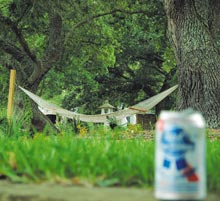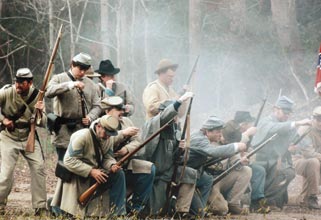A locally produced documentary makes the BIFF finals while redefining the Lowcountry’s archeological record
 On paper, Mike Hudson and Gibbes McDowell are an odd pairing. McDowell is an expert guide and outdoorsman while Hudson spends a good bit of his time blowing things up as a Special Effects Coordinator for film and television, with a resume that includes both Forrest Gump and the current Army Wives. About six years ago, the two discovered a mutual interest in history and archaeology when McDowell told Hudson about evidence of ancient Native Americans he’d discovered at his fish camp near Hunting Island.
On paper, Mike Hudson and Gibbes McDowell are an odd pairing. McDowell is an expert guide and outdoorsman while Hudson spends a good bit of his time blowing things up as a Special Effects Coordinator for film and television, with a resume that includes both Forrest Gump and the current Army Wives. About six years ago, the two discovered a mutual interest in history and archaeology when McDowell told Hudson about evidence of ancient Native Americans he’d discovered at his fish camp near Hunting Island.
What began as a hobby soon turned into a passion project with the involvement of Dr. Chester DePratter of the USC Institute of Archeology. As DePratter explains in the film, the coastal terrain and Sea Islands as we know them did not exist five thousand years ago. Over time sea levels rose and fell, islands and marshes formed and the indigenous people moved with them following food and water sources. These hunter-gatherers left behind an undiscovered bounty of artifacts and evidence of a story that has only begun to be told. The idea for a film just seemed natural.
Gibbes McDowell: Mike started riding around with me and Chester and his background in the movie business suggested we might make a film. The idea just took root and got bigger and bigger.
Mark Shaffer: For people who’ve never been out to these islands other than the ones with beaches and golf courses, this is really risky business.
Mike Hudson: You’ve got to be able pull yourself through waste deep mud that’ll suck your boots off. Dragging gear around makes it worse. We were lucky nobody got seriously hurt. We should have been snake bit, gator bit or worse.
GM: These sites are the high points of ancient beach lines. Just like modern people they preferred to camp on the high ground and that’s where we find most of these camps. Dr. DePratter says hundreds of them are probably gone, mudded over in marsh.
MS: How many sites have you identified, so far?
GM: We’ve located between fifty to seventy ourselves.
MH: A lot of these little nameless islands are hummocks with shell rings and pottery shards and shell mounds where Indians discarded this stuff for thousands of years.
GM: The story just sort of wrote itself as we started to connect the dots. The more dots you connect, the better the picture gets.
MS: So, you’ve scratched the tip of an archeological iceberg.
MH: Exactly.
MS: And there’s virtually nothing out there on the subject.
MH: Once I started researching – and I did a lot of research – I found that there’s not a lot there.
GM: Just a few dry, dusty journals – some of Chester’s predecessors in the 1890’s had catalogued a few shell ring sights down the coast. But to give you an idea of how vague that is, we found fifty or sixty that weren’t even on the map.
MH: And we found target rich environments. We walked on one little tiny hummock off of St. Helena  just full of stuff that predates tribal culture. It was all about food and weather.
just full of stuff that predates tribal culture. It was all about food and weather.
MS: You’re finding these sites mostly because of whatever these people discarded.
MH: The shells – mostly oysters and clams – a lot of pottery and there are bones that we haven’t identified yet.
GM: Big bones.
MH: Some really big bones. There’s a specialist at the University of Georgia working on that.
GM: Chester’s got a piece of pottery in his collection with a fingerprint in it.
MS: That’s an Indiana Jones moment. But all of this is basically centered on a cultural aspect to the Lowcountry that still exists in a way – the fish camp. Those islands and marshes have obviously been calling to people long before anyone originally thought.
MH: We make a point to say in the film that we’re still tapping the same resources that they did thousands of years ago – oysters, clams, fish, wildlife. We’re still doing it and in the same spots where they did it because it’s there.
GM: The continuity is undeniable, only the tools have changed.
MH: I was a big Civil War buff because I grew up in Marietta and I used to go out and find belt buckles and stuff. That’s cool, but it’s not that old. You find a piece of pottery like this (snaps fingers), and you’re hooked. You are hooked. I mean that’s history – unwritten history. You can’t put a price on that.
Sea Island Secrets: A Journey Through Time screens at BIFF 12:15 pm Thursday, February 17.








